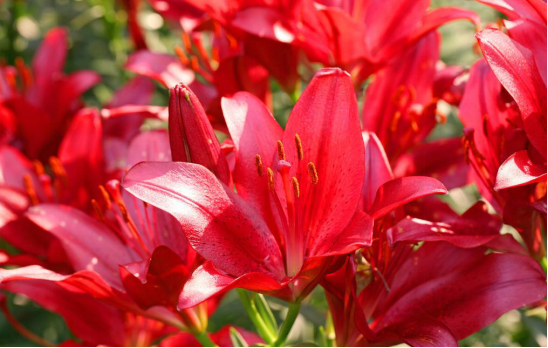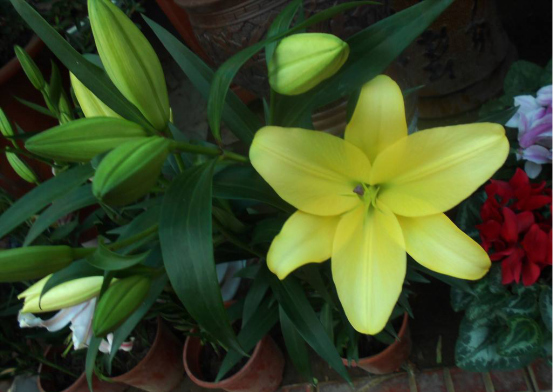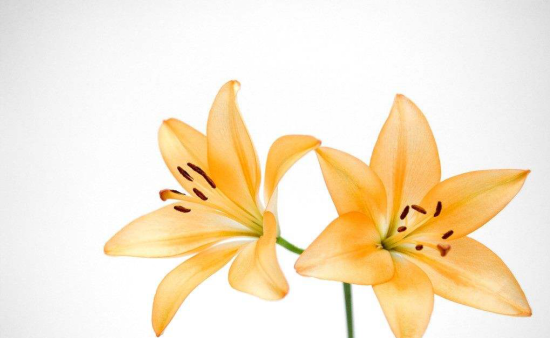Propagation methods of lilies
Sowing and reproduction
The lily seeds are collected and stored in advance, and sown in the next spring. About a month after sowing, the lily seeds will sprout, shade them in the seedling period, and can be planted separately in autumn.
Cuttage propagation
After digging out the bulb, break the scale off, wait for it to dry, cut it in the prepared soil, pour some water, and it will take root in about a month and a half.

Well, after reading the introduction given to you by the editor, did you find some of your previous mistakes? Go and correct it! I hope the supplementary breeding methods of lilies can help your lilies bloom more and more!
How to reproduce lilies the propagation methods of lilies
The appearance of lilies is fresh and refined, with a faint fragrance, and the refreshing and elegant scent of flowers is fascinating. Lilies have always been regarded as auspicious flowers. How can lilies reproduce? Today I'm going to tell you how to reproduce lilies.
1. Bulbous propagation of lilies
If you need to reproduce one or more plants, you can use the lily bulb propagation method. There are usually some small bulbs on the periphery of the stem disk of the old bulb. When lilies are harvested from September to October, these bulbs can be separated and stored in indoor sand to survive the winter. It was planted in pot in the spring of the following year. From September to October in the third year, it can grow into large bulbs and grow into large plants. The reproduction of bulbs is small, so it is only suitable for family pot propagation.
2. Sowing and propagation of lilies
Lilies can choose the method of sowing and breeding, the main method is to harvest seeds in autumn and store them until the following spring. It germinated about 20-30 days after sowing. The sun should be shaded properly in the seedling stage. At the beginning of autumn, small bulbs have been formed in the underground part, which can be dug up and planted. Due to different species, some seedlings bloom for 3 years, while others need to be cultivated for many years before they can blossom, so families should not adopt them.
3. Scale cutting propagation of lilies.
The method of lily scale cutting propagation can be used for medium number of propagation. In autumn, dig out the bulbs, break off the rich and thick scales one by one, the base of each scale should have a small part of stem disk, dry slightly in the shade, then cut it in the flowerpot or shallow wooden box containing river sand (or vermiculite), and then let the scale 2 + 3 insert into the matrix to maintain a certain humidity. Under the condition of about 20 degrees, about one and a half months, the scale wound takes root. The humidity should be kept at about 18 degrees in winter, and the river sand should not be too wet. In the spring of the following year, the scales can grow into small bulbs, divide them up, plant them in a pot, manage them carefully, and blossom after about 3 years.
4. Bulblet propagation of lily.
The method of bulblet propagation of lilies is only suitable for a few species. Such as curly Dan, yellow iron cannon and other lilies, use this method more. The practice is to remove and cultivate the bulbs (also known as "bulbs") formed in the axils of stems and leaves above ground, when the bulbs have fully grown in summer, but have not yet fallen off. It usually takes 2 to 4 years from growing into a large bulb to flowering. In order to promote the reproduction of multiple small bulbs, after flowering, the aboveground stem can be pressed and shallowly buried in the soil to divide the aboveground stem into small segments with 3 or 4 leaves, and if the stem node is buried in wet sand, small bulbs can grow in the axils of the leaves.
5. Tissue culture and propagation of lily.
The method of tissue culture and propagation of lilies is to use different parts of lilies, such as filaments, styles, ovaries and axillary buds at the base of scales, to culture test-tube plantlets, and then transplanted to the nursery bed for the production of seed bulbs.
Culture methods of lilies
The suitable temperature for the growth of lily is 1525 ℃, the temperature is lower than 10 ℃, the growth is slow, and when the temperature is more than 30 ℃, the growth is poor. In the process of growth, the temperature of 21: 23 ℃ in daytime and 15: 17 ℃ at night was the best. The bulbs that promote cultivation must be stored at 7: 10 ℃ for 4 to 6 weeks. This growth habit of lilies determines its maintenance mode. First, the choice of lily seedlings: to choose a full, robust bulb. The bulb circumference of Asian series must be 10-12 cm, and that of oriental series must be 12-14 cm. The larger the bulb, the more buds. Second, soil preparation and fertilization should be paid attention to, lilies have strong adaptability, and the climate is mild and sunny. The soil should be sandy loam with deep soil layer and good drainage, followed by clay, and waterlogged land should not be planted. Third, proper pruning and planting are beneficial to the growth of lilies. Breeding lilies can be cultivated by sowing method, scale cutting method, seed ball culture method and so on. Fourth, it should be drained when appropriate. Lilies need wet water to grow, which is beneficial to the growth of stems and leaves. If the soil is too wet, stagnant water or poor drainage, the lily bulbs will rot and die. Watering of potted lilies should be gradually increased with the growth of plants, sufficient water supply should be provided during flowering, water should be reduced after flowering, and watering should be stopped after aboveground parts withered. The basin soil is too wet, which also causes the bulb to rot. Fifth, the cultivation of lilies needs enough light. Lily likes to shine with soft light. Also resistant to strong light and semi-shade, lack of light will cause buds to fall off and reduce the number of flowers. There is plenty of light, the plants are strong and short, and the flowers are bright. 6. Disease and pest control of lilies. Lily diseases and insect pests are mainly caused by black spot, gray mold and rust, which can be controlled by spraying 500 times of 25% carbendazim wettable powder. Insect pests are harmful to grubs and aphids and can be sprayed with 1000 times of dichlorvos EC.
- Prev

Culture of lilies
Environmental soil: cultivated lily is suitable for sandy soil with good drainage and rich humus content, and it is best to choose acidic soil, which is conducive to its better growth. Temperature: the best temperature for cultivating lilies is 1624 ℃. If it is lower than 5 ℃ or higher than 30 ℃, the lilies will stop growing.
- Next

The leaves of lilies turn yellow
Water yellowing is due to the yellowing caused by watering too frequently, mainly for the yellowing of young leaves, while there is no obvious change in old leaves; as long as the moisture is controlled in time. Dry yellow is just the opposite of water yellow, which is caused by too little watering and lack of water, in which case the old leaves will turn yellow from the bottom up.
Related
- Fuxing push coffee new agricultural production and marketing class: lack of small-scale processing plants
- Jujube rice field leisure farm deep ploughing Yilan for five years to create a space for organic food and play
- Nongyu Farm-A trial of organic papaya for brave women with advanced technology
- Four points for attention in the prevention and control of diseases and insect pests of edible fungi
- How to add nutrient solution to Edible Fungi
- Is there any good way to control edible fungus mites?
- Open Inoculation Technology of Edible Fungi
- Is there any clever way to use fertilizer for edible fungus in winter?
- What agents are used to kill the pathogens of edible fungi in the mushroom shed?
- Rapid drying of Edible Fungi

